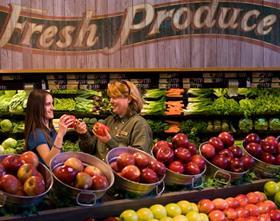
According to the annual report by market research group GfK Benelux, commissioned by Flanders’ Agricultural Marketing Board (VLAM), Belgian consumers bought almost 6 per cent less fruit and vegetables last year compared with 2013.
In 2014, the average Belgian bought 40.2kg of fresh vegetables and 47kg of fresh fruit, at a cost of €88 (-4.6 per cent) and €105 (-7 per cent) respectively.
Per capita spending on fruit and vegetables fell by a greater percentage in Belgium (-5.8 per cent) than in the food market globally (-0.8 per cent), according to the survey, which looked at 5,000 Belgian families.
This decrease in spending can be explained by lower average prices in-store and lower purchasing levels, particularly for fresh fruit, which saw both prices and volume sales fall by 3.4 per cent.
The decline was also greater in the French-speaking region of Belgium, Wallonia (-9.7 per cent), than in Flanders (-4.4 per cent), the survey revealed.
Tomatoes, the top vegetable consumed, bucked the general trend, with sales rising by 1 per cent in volume terms and 4 per cent in value. The popularity of cherry tomatoes, in particular, has rocketed - they now account for 17 per cent of volume and 33 per cent of value sales, making them the most important segment in value terms.
Cauliflower, leeks, paprika and peppers also showed some growth, as did runner beans, asparagus, oyster mushrooms, rocket, iceberg lettuce, mixed vegetables, sprouts and spinach.
Those vegetables experiencing the biggest drops were red cabbage, white cabbage and Savoy cabbage, French beans and chicory. Sales of chicory fell by 10 per cent in volume, and by 8 per cent in value.
In the fresh fruit top ten, apples remain the leaders despite losing 3.7 per cent in volume and 13.5 per cent in value. Jonagold remains the market leader with 43 per cent of the volume, but the current trend sees traditional apple varieties such as Jonagold and Golden Delicious losing ground to newer varieties like Braeburn, Belgica, Kanzi and Pink Lady.
Strawberries saw volume sales rise by 9 per cent due to lower prices, while pears saw sales rise by 29 per cent in volume, a result of the successful ‘eat local’ campaigns that followed the Russian ban.



